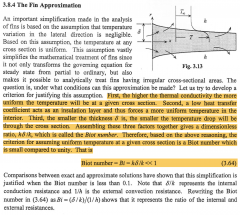![]()
![]()
![]()
Use LEFT and RIGHT arrow keys to navigate between flashcards;
Use UP and DOWN arrow keys to flip the card;
H to show hint;
A reads text to speech;
9 Cards in this Set
- Front
- Back
|
What is the difference between heat transfer and thermodynamics? |
In a thermodynamics system we study systems in equilibrium. That is, all properties, including temperature are uniform in the entire system. In heat transfer the temperature in a system is not uniform. If it were, there would be no heat transfer. (pg. 2) |
|
|
What determines the heat transfer coefficient, h? |
Geometry, fluid properties (denisty, viscosity, specific heat, and conductivity), motion and in some cases temperature difference. (pg. 5) |
|
|
What are the three modes of heat transfer and their corresponding laws |
Conduction (Fourier's Law), Convection (Newton's Law of Cooling), Radiation (Stefan-Boltzman law). (pg. 3-7) |
|
|
What is the difference between local and average h? |
In general, the heat transfer coefficient h is not uniform over a surface. Its value at any given point on the surface is referred to as the local heat transfer coefficient. It is, however, conveninent to define an average value, h(bar), for an entire surface. (pg. 5) |
|
|
Why is there a negative sign in Fourier's Law? |
The negative sign means that when the gradient is negative, heat flow is in the positive direction, i.e., towards the direction of decreasing temperature, as dictataed by the second law of thermodynamics (pg. 4) |
|
|
From what law is the heat conduction equation derived? |
Conservation of energy (pg. 15) |
|
|
What is the physical significane of each term in the heat conduction equation (2.5) |
The first three terms represent the net rate of energy conducted in the x, y, and z directions, respectively. The fourth term represents the rate of energy generation and the fifth term is the rate of energy storage. |
|
|
What is the purpose of the fin approximation and what is the basis of its approximation? |
"An important simplification made in the analysis of fins is based on the assumption that temperature variation in the lateral direction is negligible. Based on this assumption the temperature at any cross section is uniform. This assumption vastly simplifies the mathematical treatment of fins since it not only transforms the governing equations for steady state from partial to ordinary, but also makes it possible to analytically treat fins having irregular cross-sectional areas." pg. 41. |
|
|
What is the criterion for assuming uniform termperature at a given cross section? |

|

